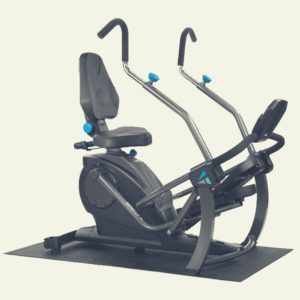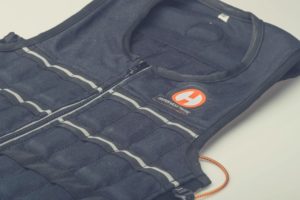Whether you prefer low impact exercise to high impact exercise to improve your overall health and well being, to maintain your quality of life, or to lose weight, a recumbent cross trainer helps you do it all via one machine that’s also easy on the joints, which is why it is also uniquely designed for joint rehab patients.
In fact, this type of machine differs from other workout equipment in that it includes a seat, which helps prevent your total body weight from bearing down on your sockets, hinges, and more while you exercise for decreased strain and pain both during and afterward.
However, when it comes to choosing the best recumbent cross trainer, especially for joint rehab patients, there are a few things you need to look for to ensure a safe and comfortable ride.
Hence, we’ll begin by covering a few of them and then follow up with a review of the top 5 recumbent cross trainers for joint rehab patients to help you find the best one for you.
How to Choose the Best Type of Recumbent Cross Trainer for Joint Rehab Patients
Recumbent cross trainers, in general, are developed to give you a full-body workout without placing too much pressure on the back, knees, hips, and more.
However, they vary in additional features, which will ultimately determine the most suitable machine to meet your needs.
That being said, some basic features to look for in a recumbent cross trainer that is good for the joints include:
Stride Technology
The stride technology of the machine determines how smooth of an exercise motion you will experience when using it.
Therefore, you want to look for one that stresses it’s licensed from commercial equipment, which means it offers the same therapeutic functionality as the machines used by physical therapists in-office.
You should also consider the pedal motion of the machine because some of them move in a circular manner, while others use a more linear movement, which provides the lowest impact on the joints.
Build and Weight
The build and weight should also be considered when choosing a recumbent cross trainer because it will determine its stability when in use, as well as its ease of maneuverability when positioning into place in your home.
Some also include transportable wheels to help make it easier to move.
Meanwhile, machines built with a low step-through design will help you keep your balance as you enter and exit the machine for added safety.
Adjustable Arm Handles
All cross trainers also include moving handlebars, which makes it possible to get both an upper and lower body workout.
However, you want to ensure the handlebars are also adjustable to keep you from overextending your upper body to reach them, which can strain your muscles and cause pain.
Workout Variety/Resistance
Some machines also enable you to change your workouts and resistance as needed to help kick up the challenge and reach your goals.
Many models also include rotating handles with interchangeable grips to help you target different muscles in the upper body.
Swivel Seat With Back
A rotating seat is important on a recumbent cross trainer because it enables users to get on and off the machine with no problems. Some also lock into place for added safety.
The seat should also include a back to help protect the muscles in the lumbar region, and some also recline for added comfort.
Lockable Pedals and Handles
The handles and pedals should also securely lock in place to allow you to enter and exit the unit without falling.
Some are also equipped with adjustable foot straps to help keep your feet stable and secure while pedaling to get the most out of your workout and avoid injury.
Monitor/Display
Most recumbent cross trainers for joint rehab patients also feature a monitor or LCD to track your metrics, such as speed, distance, calories burned, and more.
So be sure your chosen model includes a display that provides the statistics you want to track to help ensure you reach your target marks.
Warranty
Though recumbent trainers for home use are typically priced significantly lower than commercial-grade machines, they are still quite an investment, so be sure your chosen unit also includes a warranty to help prevent you from having to pay out of costs in the event there is a product defect.
What are the Advantages/Benefits of a Recumbent Cross Trainer? What’s the Best Way to Use It?
The main advantage of a recumbent cross trainer is that it provides more support for the knees and other joints compared to other forms of exercise.
However, there is a common myth that exercise equipment that works your knees can actually damage your joints by causing them to move in a way that is not natural to the body.
But experts state that this is simply not the case as long as you use the machine correctly, which includes not fully extending the knee and elbow joints when pushing the handlebars and pedals away to avoid straining them.
They stress that you should also start slow and then work your way to a more challenging level once you are comfortable and always stop exercising if you feel pain.
Those with injuries should also get permission from their physician before using a recumbent machine to avoid further damaging the joints.
Recumbent Cross Trainer for Joint Rehab Patients Reviews
NuStep T5 Recumbent Cross Trainer
The NuStep T5 Recumbent Cross Trainer is the company’s mid-level model recumbent cross trainer that also adjusts to fit a wide range of users.
It’s also easy to use and includes an abundance of features for people recovering from balance issues and more to work out safely, including:
Pros:
- It has a low step design, so it is easy to get onto and off of.
- It includes up to 8 different resistance levels.
- It has a large LCD color display to track your stats.
- Its large and comfortable seat swivels 360 degrees and also locks at every 45 degree angle to safely get off and onto the machine.
- It has adjustable arm handles, so users can choose their appropriate arm handle length, and they also include rubber hand grips for added stability.
- The foot pedals also adjust to accommodate feet of all sizes, and they also include heel cups to help keep your feet on the pedals as you exercise.
- The handles and pedals also lock for added safety when exiting or getting on to the cross trainer.
- A water bottle holder and heart monitor is also included.
Cons:
- It costs a bit more than other machines of its kind.
Marcypro Dual Action Cross Training Recumbent Exercise Bike with Arm Exercisers
The Marcypro Dual Action Cross Training Recumbent Exercise Bike with Arm Exercisers is a 60 x 16 x 39″ black alloy steel constructed recumbent cross trainer that boasts extreme durability for long-lasting workouts.
Some other features include:
Pros:
- It includes a manual magnetic resistance mechanism and 8 levels of resistance to simulate riding the bike through various terrains.
- It also includes an easy-to-read display to track your, calories, distance, and more.
- The handlebars are also adjustable to suit a variety of users.
- It also includes a smooth adjusting, high-density foam padded seat and back for extra comfort while riding.
- It also has a water bottle holder.
Cons:
- The assembly may be a bit complicated.
- It may not be suitable for larger users.
HCI Fitness PhysioStep LXT-700, Recumbent Linear Step Cross Trainer
The HCI Fitness PhysioStep LXT-700, Recumbent Linear Step Cross Trainer is a 60 x 40 x 30 grey alloy steel machine that is used by physical therapists around the world.
It features a transition platform that makes it easy to put your feet into and out of the pedals, and its compact design easily fits through doors 2.5′ x 5′.
It also includes roller wheels to easily position it into place.
Some other features include:
Pros:
- It accommodates users up to 6’4″ and 400 pounds.
- Its ergonomic design makes it suitable for a wide range of users.
- The easy-to-read LCD is adjustable and includes over 19 workout programs to choose from and up to 32 resistance levels.
- Its patented 2:1 natural stepping motion makes it the only patented linear stepper on the market.
- Its 20″, 360 degree swivel seat is made of orthopedic foam, and it also slides and reclines to accommodate different users.
- The handles also swivel to help make it easier to get onto and off the machine.
- It also includes a built-in contact heart rate monitor on the seat handles.
- It’s made in the USA.
Cons:
- The assembly may be a bit complicated.
- It may make a slight noise until it’s broken in.
Teeter FreeStep Recumbent Cross Trainer and Elliptical
The Teeter FreeStep Recumbent Cross Trainer and Elliptical is a 54 x 29 x 52. 5″ commercial grade engineering patented exerciser, which includes a patented friction-free linkage system to ensure long-lasting use.
Its patented technology is also provided by the same maker of high-end physiotherapy steppers used by physical therapists but in an affordable at-home solution.
Some other features include:

Pros:
- It accommodates users up to 300 pounds.
- Its naturally reclined seated position reduces body fatigue while exercising.
- Users can also isolate their legs and upper chest for a more targeted workout.
- Its whisper quiet, fluid stride follows a smooth, linear path to protect the joints.
- It also includes variable magnetic resistance from 0 to intense for added challenge.
- Its battery operated LCD enables users to track their stats via an easy-to-read design.
- It also includes a water bottle holder, heavy duty mat, and transport wheels.
- It arrives 65% assembled.
- The company provides good customer service.
Cons:
- it does not include a heart rate register.
- There may be some issues with assembly/durability.
Related: Check Out Our Full Review of the Teeter Freestep Recumbent Cross Trainer here.
XTERRA Fitness RSX1500 Seated Stepper
The XTERRA Fitness RSX1500 Seated Stepper is a 52.1 x 14.7 x 50″ black steel workout machine that enables users to exercise from a semi-recumbent position, which makes it suitable for rehab users and more up to 6’2 and 300 pounds.
It also features a sturdy walk-through frame to help maintain your balance when getting onto and off the machine.
Some other features include:
Pros:
- Its natural and coordinated leg and arm motion provides users with a comfortable total body workout.
- It also includes smooth bearings for a more comfortable ride.
- It includes a large, easy-to-read display for tracking your stats. It also includes a heart monitor in the hand pulse grips.
- Users can choose from 24 programs.
- It also includes a comfortable mesh back seat for added comfort.
- The leg motion provides a full 13″ step range to accommodate various users.
- The handles also adjust to suit different users.
- The hand grips also swivel 360 degrees for added comfort.
- The company provides good customer service.
Cons:
- It may be a bit noisy at first.
Related: Check Out Our Full Review of the XTERRA Fitness RSX1500 here.
Conclusion
The PhysioStep LXT appears to be the best pick for joint rehab patients because it is the same equipment used by physical therapists in the field, so you know you are getting comparable in-office results when using it at home.
Meanwhile, the Teeter FreeStep’s patented technology is licensed by the same maker of high-end physiotherapy steppers used by physical therapists, so it offers a more affordable but effective way to continue rehab at home.
The NuStep Recumbent Cross Trainer is used by physical therapists as well, so it’s also easy for rehab patients to use.
Otherwise, if you are just looking for a gentler, more joint-friendly way to stay active at home, then you may consider choosing the XTERRA Fitness RSX1500 or the Marcypro Dual Action Cross Training Recumbent Exercise Bike with Arm Exercisers, which are created for fitness enthusiasts of all skill levels.








